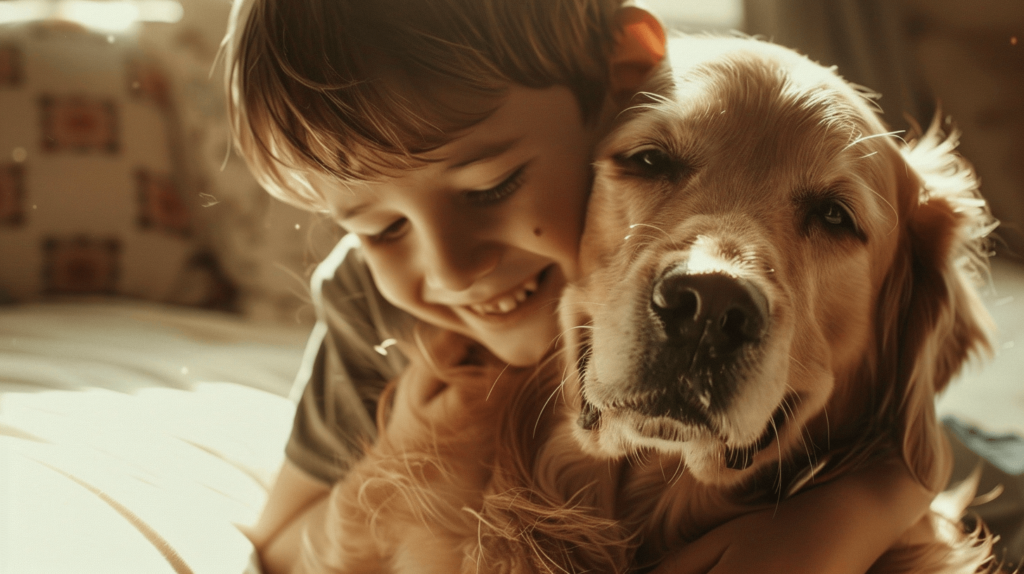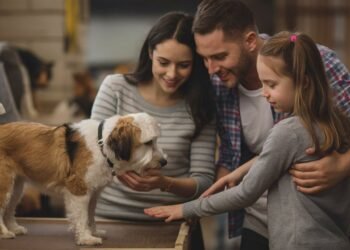Overcoming Separation Anxiety in Dogs:
Effective Training and Tips
Introduction to Training Your Dog to Handle Being Alone
Why It’s a Big Deal When You Leave: Understanding Separation Anxiety in Dogs
Have you ever felt a pang of guilt as you closed the door behind you, leaving your dog’s sad eyes staring out the window? If so, you’re not alone. Many dog owners grapple with the effects of separation anxiety on their furry friends, which can turn a routine goodbye into a heart-wrenching scene. Separation anxiety isn’t just about a dog missing its human—it’s about a deep-rooted panic that envelops them, making each departure feel like it could be the last. This anxiety can manifest in various disruptive behaviors: from incessant barking and chewing up the couch cushions to more distressing actions like self-injury or attempting escapes.
Understanding that your dog’s behavior is driven by anxiety rather than mischief is crucial. It shifts how we approach solutions, framing them not as punishments but as support systems to help our dogs cope better. When we start to see the world from their perspective, we can appreciate just how disorienting our absence might be. Think about it—dogs don’t have a concept of time like we do, so every minute you’re gone could feel interminable to them.
Emotional Rollercoaster: Building an Emotional Bridge
Building an emotional bridge with a dog suffering from separation anxiety is about establishing trust and a sense of security. It starts with recognizing their distress signals and responding to them in ways that affirm their feelings without reinforcing their fears. For example, if your departure cues (like grabbing your keys or putting on your coat) start your dog’s anxiety engine, consider how you might alter these rituals to reduce their impact.
Engagement is key here. Before leaving, a calm, reassuring cuddle or a playful interaction can help ease the transition. You might also leave behind a piece of clothing with your scent or a soothing toy to keep them company. The goal is to make your absence less daunting, showing your dog that being alone can be a positive, calm experience. Over time, these small reassurances can build a scaffold of comfort around the times you’re away, slowly reshaping their emotional landscape towards one of security and peace.
Practical Magic: Environment and Routine Changes
Finally, let’s talk environment and routine—two elements that might seem mundane but hold magical powers in the context of separation anxiety. Creating a safe, comforting space for your dog can make a world of difference. This could be a cozy corner with their favorite blanket, a crate they can retreat to, or a window with a view where they can watch the world go by. Consistency in your routines also plays a pivotal role. Dogs thrive on predictability, so keeping a regular schedule for meals, walks, and cuddle times can help stabilize their mood throughout the day.
Moreover, consider the power of a good workout before you leave. A tired dog is a happy dog, and a good round of fetch or a brisk walk can help burn off some of that anxious energy. By incorporating these practical adjustments into your daily routine, you can help your dog associate your departure with a peaceful time rather than a stressful one. It’s about turning the unknown of ‘being alone’ into the familiar and manageable—a transformation that’s truly a bit of practical magic in the world of dog parenting.
By addressing separation anxiety from these angles—understanding its roots, building emotional support, and adjusting the environment—we can help our dogs feel more comfortable and confident, even when we have to step out without them.
Defining Separation Anxiety and Its Manifestations
Separation anxiety in dogs is a distressing emotional disorder that occurs when a dog is excessively attached to its owner and becomes extremely stressed when left alone. This anxiety is more than just a mild inconvenience; it can lead to significant behavioral issues. The symptoms are varied and can be quite destructive. Common manifestations include destructive behavior, such as chewing furniture, tearing up pillows, or digging at doors and windows in an attempt to escape. Excessive barking, howling, or whining are auditory signs that a dog is suffering from separation anxiety. These sounds are typically loud, persistent, and meant to summon the missing owner back home. Additionally, inappropriate elimination—urinating or defecating inside the house despite being house-trained—is another clear signal of distress. These behaviors are not only problematic but also indicate the profound unease and inability to cope with solitude that affected dogs feel.
Emotional Stress and Triggers of Separation Anxiety
The emotional turmoil experienced by dogs with separation anxiety stems from a deep-seated fear of abandonment that triggers intense stress reactions. Dogs are pack animals by nature, and being isolated from their pack leader—the owner—can feel overwhelmingly threatening. Several triggers can exacerbate this anxiety. Changes in routine, such as a new job schedule that alters the time spent together, or moving to a new home, can destabilize a dog’s sense of security and exacerbate anxiety. Even subtle changes, like a different departure routine, can set off a panic response in sensitive dogs. For dogs with a history of rehoming or shelter stays, the fear of being left alone again can be particularly profound. Understanding these emotional triggers is crucial for developing strategies to help alleviate their stress and manage their anxiety effectively. By addressing the root of their fear, owners can begin to implement calming techniques that reassure and support their pets even when they can’t be together.
Root Causes and Common Triggers
Separation anxiety in dogs can stem from several root causes, each contributing to an overwhelming fear of being left alone. One of the primary causes is a change in routine, which can unsettle a dog’s sense of security. Dogs thrive on predictability, and disruptions to their daily schedule—such as a change in the owner’s work hours or moving to a new home—can be particularly distressing. Another significant factor is a lack of early socialization. Dogs that aren’t exposed to a variety of people, places, and situations during their formative weeks may become overly dependent on their primary caretaker, as they haven’t learned to feel safe in different environments or with different people.
Past traumas are also a critical cause of separation anxiety. Dogs that have been rehomed multiple times, or those that have experienced abandonment, are more susceptible to developing separation anxiety. The fear that their current situation may not be permanent can cause them to panic when they find themselves alone.
Exacerbation by Attachment to a Single Person

Attachment to a single person can severely exacerbate separation anxiety. When a dog forms an intense, exclusive bond with one individual, they may become hyper-sensitive to that person’s presence and absence. This can be seen in homes where one member is primarily responsible for feeding, walking, and playing, making them the main source of the dog’s comfort and security. When that person leaves, the dog may feel vulnerable and excessively stressed, fearing that their protector may not return. This hyper-attachment makes it difficult for the dog to find comfort with other family members, which could otherwise help alleviate some anxiety during the owner’s absence.
In addressing separation anxiety, it’s crucial to understand these underlying causes and consider ways to mitigate them, such as maintaining a stable routine, ensuring proper socialization from a young age, and distributing caregiving tasks among several household members to prevent hyper-attachment to a single person.
Introducing Gradual Desensitization to Being Alone
Managing and reducing separation anxiety in dogs often revolves around a key technique: gradual desensitization. This method gently accustoms your dog to being alone, minimizing their stress and anxiety gradually over time. The essence of desensitization is to expose your dog to their fear of being alone in such small, controlled increments that they don’t react with anxiety. It’s like dipping your toes into the water before taking the plunge!
Step-by-Step Approach to Training Dogs to Feel Safe When Left Alone
- Start Small: Begin with leaving your dog alone for just a few minutes at a time while you’re still in the house. You might start by stepping into another room and closing the door briefly. The goal here is to return before your dog becomes anxious, gradually increasing their comfort with your absence. If you’re working from home, you could start by leaving your dog in a designated space while you go to another room to work or perform a household chore. Begin with short periods, like 5 minutes, and gradually increase the time as your dog gets more comfortable. The key is to come back before they show signs of anxiety, such as pacing or whining.
- Use a cue: Establish a word or action that you consistently use when leaving the house that can signal to your dog that you will return. Something as simple as saying “Be right back!” in a cheerful tone every time before you leave can set the expectation. Every time you leave the house, you could use a specific phrase like “I’ll be back soon” in a calm and happy tone. Over time, your dog will begin to understand this cue means you will return, and it’s not a signal to start worrying.
- Provide comfort: Leave your dog with comforting items such as a piece of clothing that smells like you, a favorite toy, or a treat-dispensing toy that can keep them busy. These items can provide a sense of security and distraction. Leave a worn t-shirt or a blanket that smells like you with your dog when you go out. Additionally, you could leave a puzzle toy filled with treats to keep them busy, which helps to distract them from your absence and provides comfort.
- Practice leaving: Do practice runs of your departure routine more frequently, without making a big deal about coming and going. Grab your keys, put on your coat, and go through the motions of leaving, then come back in a few minutes. This helps your dog learn that these cues don’t always lead to long periods of separation. Incorporate your usual ‘leaving’ signals into your daily routine without actually leaving. For example, pick up your keys and put on your jacket at various times throughout the day, then sit down on the couch or do some household tasks. This method helps desensitize your dog to the triggers that indicate you are leaving.
- Keep greetings low key: When you return home, keep your greetings calm and low-key to communicate that leaving and returning are normal and not a big deal. When you come back home, make sure to keep your greetings subdued. Calmly pet your dog and go about your normal routine instead of excitingly fussing over them. This behavior sets a tone that leaving and returning is a normal part of the day.
- Increase Time Gradually: Slowly extend the amount of time you are away. After your dog seems comfortable with a few minutes, increase to 10 minutes, then 20, and so on. Always aim to return before your dog becomes distressed. After your dog has become accustomed to being alone for short periods inside the house, start extending the time you are away. For instance, take a quick walk around the block or a trip to the mailbox and gradually increase these outings to longer walks or a run to the store.
- Reward Calm Behavior: Upon returning, if your dog remained calm, reward them with a treat or affection. This reinforces the behavior you want to encourage. When you return home and find that your dog has been calm during your absence, immediately reward them with a treat or their favorite toy. This positive reinforcement helps them associate your departure and return with something good.
Creating a Comforting Environment
One effective way to alleviate separation anxiety in dogs is by optimizing their environment to reduce stress. This can be achieved by creating a dedicated space where your dog feels safe and secure. Consider setting up a crate or a specific area in your home that serves as their sanctuary. The use of a crate can be particularly comforting because it mimics a den-like space, which is naturally soothing for dogs. To enhance this space, include items with familiar scents, such as a blanket or a piece of clothing that smells like you. This helps reinforce the feeling of safety and can be incredibly comforting to your dog while you’re away.
Additionally, make sure the environment is conducive to relaxation. This means considering factors like temperature, lighting, and noise levels. A calm, quiet area with soft bedding and perhaps some gentle, ambient sounds (like a white noise machine or soft music) can help soothe your dog’s nerves. It’s also important to ensure that this area is away from high-traffic zones in the home to minimize disturbances.
Engaging toys and activities
To help your dog cope with the anxiety of being alone, providing engaging toys and activities is key. Toys that stimulate their mind and encourage active engagement are especially beneficial. Treat-dispensing toys, such as a Kong filled with peanut butter or specialized chew toys, can keep your dog occupied for extended periods. These toys not only provide entertainment but also challenge their problem-solving skills, which can help distract them from your absence.
Puzzle toys are another great option, as they require your dog to work out how to obtain a reward, which can significantly divert their attention away from anxiety-inducing stimuli. Rotating the toys regularly can also help maintain your dog’s interest, as the novelty of a new toy can be particularly engaging.

In addition to toys, consider activities that can be set up before you leave that encourage independent play. For example, hiding treats around the house for your dog to find can provide a fun, stimulating activity that keeps their mind active while you’re not there. This not only helps reduce feelings of loneliness but also tires them out physically and mentally, making them more likely to rest peacefully during your absence. By combining environmental modifications with engaging toys and activities, you can help create a more relaxed atmosphere for your dog. These strategies not only help manage and reduce symptoms of separation anxiety but also enhance your dog’s overall well-being, making the time they spend alone more enjoyable and stress-free.
When to consult a professional
While many cases of separation anxiety in dogs can be managed with the behavioral and environmental strategies discussed previously, there are times when professional intervention becomes necessary. If your dog’s anxiety symptoms are severe, persistent, and do not improve despite your best efforts at training and environmental modification, it might be time to consult a professional. This could be a veterinarian or a certified dog behaviorist who specializes in behavioral issues.
Severe symptoms might include extreme destructiveness that poses a danger to your dog’s health (like chewing through walls or doors), self-injury, or panic attacks that lead to physical symptoms like excessive drooling or panting. A professional can assess the situation through a behavioral consultation and provide tailored strategies that are more intensive and directed. They can also determine if there are underlying medical issues contributing to the anxiety, which can sometimes be the case.
Therapy and Medication
In addition to behavioral therapy and training, there are medical treatments that can help manage anxiety levels in dogs. Veterinarians can prescribe medications that alleviate anxiety, such as antidepressants or anti-anxiety drugs. These medications can help stabilize your dog’s mood and reduce the intensity of their anxiety responses, making it easier for them to cope with being alone.
Therapy options might include structured behavior modification programs that use positive reinforcement to teach the dog to associate being alone with pleasant experiences. Some professionals might also use techniques such as counter-conditioning or systematic desensitization to gradually reduce the dog’s anxiety about being separated from their owner.
It’s crucial to follow the guidance of a professional when using these treatments, as they will tailor the approach to your dog’s specific needs and monitor their progress. The goal is to achieve a long-term solution that allows your dog to feel secure and calm even in your absence, improving the quality of life for both you and your pet. Always discuss any concerns about your dog’s behavior with your vet to decide the best course of action.
Consulting Professionals for Advanced Cases: If you notice persistent signs of separation anxiety in your dog that don’t improve with basic interventions, it’s important to seek professional help. Veterinarians or certified dog behaviorists can offer more specialized guidance and treatment options, ensuring your dog receives the best possible care. Don’t hesitate to reach out to a professional if your dog’s anxiety is severe or if you feel overwhelmed.
Share Your Experiences and Tips: Your experiences and strategies might be invaluable to other dog owners facing similar challenges. Please share your stories, tips, and any questions you might have in the comments section below. Whether it’s a successful training technique or a comforting routine that worked for your pet, your insights can help create a supportive community of pet owners who are all striving to make their dogs’ lives better. Let’s connect and learn from each other’s experiences in managing separation anxiety in dogs.












